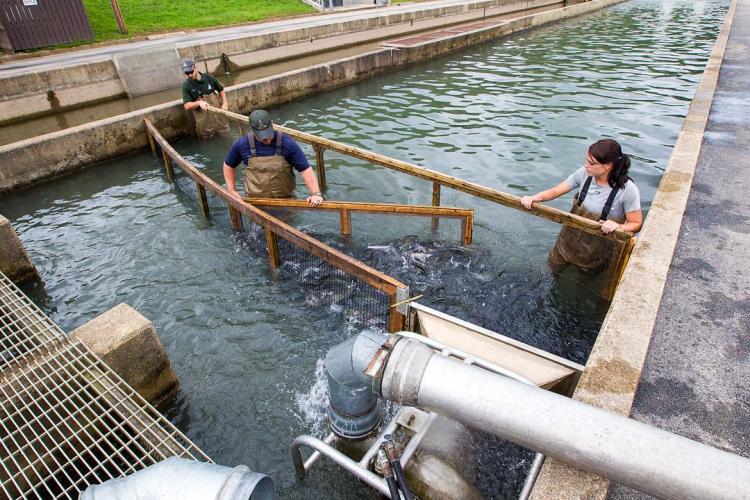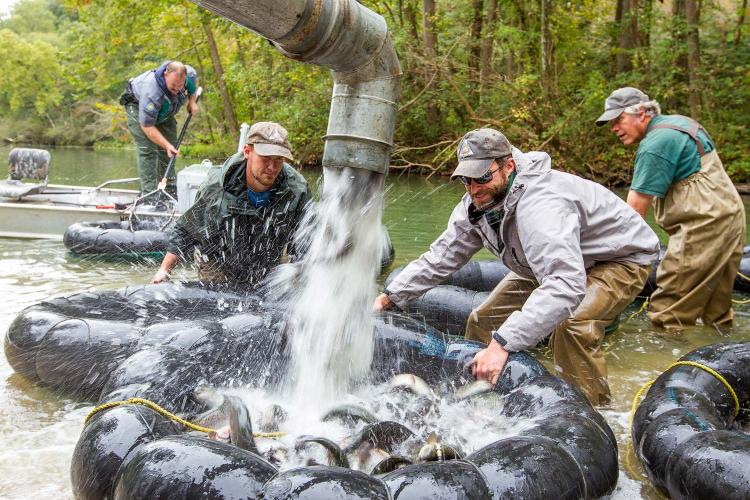Ben Havens watched rainbow trout swim in water clear enough to read through and reflected on the significance of his job as a hatchery manager. The work, he said, is as much about providing memories as it is about producing fish.
“People take this place (Bennett Spring State Park) and hold it near and dear to their hearts,” said the manager of MDC’s Bennett Spring Hatchery. “This place is a part of them.”
Trout fishing, he explained, is what has endeared this state park in Laclede and Dallas counties to generations of visitors.
Bennett Spring isn’t the only Missouri locale where trout provide tranquility. The state’s other three trout parks — Roaring River State Park (Barry County), Montauk State Park (Dent County), and Maramec Spring Park (Phelps County) — have long been destinations where trout fishing has been the primary method to rest, relax, and recharge.
Fishing by the Numbers
Missouri’s trout-fishing areas — which primarily consist of four trout parks, 2,080-acre Lake Taneycomo, and more than 100 miles of streams — get a steady flow of anglers throughout the year. Surveys show Missourians spend 1.4 million days fishing for trout each year. Missouri trout fishing generates retail sales of $104 million annually and has an annual economic impact of $187 million.
Rainbow and brown trout may be the lifeblood of this thriving fishing activity, but its heart is MDC’s coldwater hatchery system. A network of five MDCoperated hatcheries — Shepherd of the Hills (Taney County), Bennett Spring, Roaring River, Montauk, and Maramec Spring — produce more than 1.6 million fish per year. The hatcheries’ output is critical because very little natural trout reproduction takes place in the state.
The Science of Trout
Satisfying Missouri’s appetite for trout fishing is a job that’s unique, challenging, science-based, and technology-driven. “Hatchery managers now need to be well-trained to operate a variety of complex equipment,” said Roaring River Hatchery Manager Paul Spurgeon. “Fishrearing equipment now includes oxygen injection, ultra-violet disinfection, pumping systems that include variablespeed computer-controlled output, and machines that provide computer-monitored growth predictions and feeding rates.”
Raising trout from the egg stage to a stocking size of 12 inches is a two-year process that starts in the late fall or early winter. This is when eggs are taken from females and fertilized with milt (the trout equivalent of sperm) extracted from the males.
Fertilized eggs are put in specialized incubation holders, called “up-wellingjars,” where their progress is monitored and manipulated for the goal of hatching success. When hatching occurs in 22 days, the tiny sac-fry, or newborn fish, are put in special holding tanks inside the hatchery building. Here, the combination of frequent feedings and temperature and light regulation transform the sac-fry to swim-up fry in 14–18 days.
At approximately 40 days, the swim-up fry have reached the fingerling stage of development and now measure 1.5–4 inches in length. From fingerlings, they grow to sub-adults, and then to 12-inch fish that are ready for stocking.
A steady supply of cold water is the foundation of each of MDC’s hatcheries. This is similar to the water found in a trout’s native habitat of northern California and the Pacific Northwest, and it is an essential part of trout propagation. AtBennett Spring, Roaring River, Montauk, and Maramec Spring, cold water comes from naturally occurring springs. At Shepherd of the Hills, the cold water comes from the bottom of Table Rock Lake and gets released through Table Rock Dam to the hatchery and the adjacent Lake Taneycomo.
Monitoring and Manipulation
Cold water at the hatcheries may be a replication of the fish’s ancestral habitat, but few of the other conditions mimic life in the wild. At a hatchery, a trout’s life is one of constant monitoring and occasional manipulation.
“One way you can manipulate your fish production is by regulating temperatures,” said Shepherd of the Hills Hatchery Manager Clint Hale. “The colder the water, the slower the hatch and growth; the warmer the water, the quicker the hatch and growth.” Food intake is another way to control growth, says Maramec Spring Hatchery Manager Wes Swee.
“Using a grade rack, we can separate the fast-growers from the slow-growers. Then we manipulate growth even more by the amounts of feed we provide,” he said.
The end goal, Swee explained, is to have multiple pools of fish of different sizes, which in turn, would ensure a constant process of fish growing to stocker size throughout the trout park’s summer season, March–October.
Finicky Eaters
Not just any fish food can be used at a trout hatchery.
“All our fish feed has to meet strict nutritional standards,” Hale said. “It can only have so much fat, so much protein, and so much nondigestible material.”
In addition to producing well-fed trout, hatchery personnel have to make sure their prized possessions stay healthy. As a result, at Shepherd of the Hills, Hale explained the fish are treated for parasites with medicated water, bacteria are treated with medicated feed, and other diseases are treated with dip vaccinations. He added that all MDC hatcheries have health procedures and protocols they practice on a regular basis.
Duty Calls Year-Round
Technology is part of hatchery operations in areas other than fish-rearing buildings. MDC’s hatcheries feature specialized mowers that cut vegetation beneath the surface of the water at the trout parks. There are also crane-hoist trucks, fish-loading towers, specialized filters that can block particles as small as 60-millionths of a meter.
Put it all together and you have a job that’s unique and fascinating and has duties throughout the year.
“Fish production is year-round,” said Montauk Hatchery Manager Tom Whelan. “Spawning at Montauk is September through December. We stock the park daily from March through October. November through February is the catch-and-release season. In February we are getting ready for the March 1 trout opener and the summer season that follows. In October we are getting ready to stock the CAP (Community Assistance Program) and the winter urban lakes (a program at select urban sites around the state).
“All five hatcheries are staffed daily,” Whelan continued. “The monitoring of flowing water, the monitoring of fish in the rearing systems, and overall site security are the main reasons hatcheries are staffed around the clock. Even something that seems as minor as trees dropping their leaves in the fall can cause problems with water flow. Thirty minutes without adequate water flow can result in a major loss of fish.”
Jacks of All Trades
Because it doesn’t take long for small issues to become big problems at a fish hatchery, managers and their staff have to be skilled in more than growing fish. When a problem arises, they have to be ready to fix it.
“As technology is added to the hatcheries, plumbing and electrical problems need to be trouble-shot and repaired immediately — even if that means in the middle of the night — to keep the fish alive,” said James Civiello, MDC’s hatchery systems manager for the entire state.
Sharing is Caring
Despite the best surveillance, monitoring, and maintenance, problems do occasionally occur that affect a hatchery’s production for that year. When issues arise or demand at one site simply strips supply, MDC’s other coldwater hatcheries are available to help. Fish sharing between hatcheries is a frequent annual occurrence. Thus, it’s not uncommon for one trout to have more than one hatchery home over the course of a year.
“Sometimes we trade trout to help out another hatchery after a loss,” Havens said. “Sometimes hatcheries can’t raise enough fish due to space constraints. We help each other as much as we can, whenever we can.”
Spurgeon agreed. “Fish are traded routinely,” he said. “Our strength can help another hatchery’s temporary weakness and that goes around the table. The fish are constantly moving as a unit. That’s normal — completely normal.” Civiello continued. “Flooding, drought, disease, and predation in any combination can impact any one hatchery at any time,” he said. “Our fish production is shared statewide to ensure the number of fish of usable size are available throughout the year. The hatchery teams’ surpluses of fish at one location will compensate for losses of another.”
Though the challenges of a hatchery manager’s job are many and neverending, all agreed the rewards make the work worthwhile.
“To me, the greatest reward is being able to see the fruits of your labor every day,” Whelan said. “Seeing people catch fish you have raised and realizing that you played a small part in helping to create a memory that some angler and someone close to them experienced — a memory that they might continue to share and experience with others for many generations to come — that’s the best thing about my job.”
- Annually MDC’s five coldwater hatcheries produce > 1.6 million fish
- Missourians spend 1.4 million days fishing for trout
- GENERATES $104 million in retail sales
- $187 million economic impact
National Fish Hatchery
Missouri is home to the oldest operating federal fish hatchery in the United States. Located in the Ozark Mountain Region in southwest Missouri, the U.S. Fish and Wildlife Service (USFWS) established the Neosho National Fish Hatchery in 1888. Over the years, more than 130 different species of fish have been raised there, but today the hatchery rears primarily rainbow trout, pallid sturgeon, and Topeka shiners. It is one of 70 hatcheries operated by the USFWS with a mission to conserve and protect our nation’s fishery resources.
Places To Go
Missouri has a wealth of trout waters, including red, white, and blue ribbon areas. To find a body of water near you, visit short.mdc.mo.gov/Zou.






























Also In This Issue


And More...
This Issue's Staff
Associate Editor - Bonnie Chasteen
Staff Writer - Larry Archer
Staff Writer - Heather Feeler
Staff Writer - Kristie Hilgedick
Staff Writer - Joe Jerek
Creative Director - Stephanie Thurber
Art Director - Cliff White
Designer - Les Fortenberry
Designer - Marci Porter
Photographer - Noppadol Paothong
Photographer - David Stonner
Circulation - Laura Scheuler






















